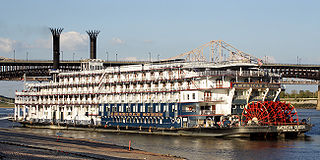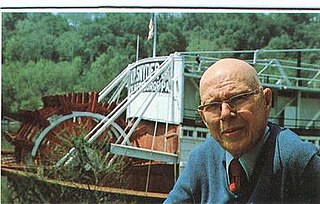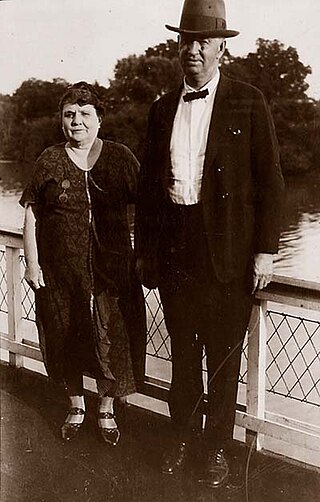
The Greene Line was a line of river steamships along the Ohio River. The name was changed in 1973 to Delta Queen Steamboat Company.

The Greene Line was a line of river steamships along the Ohio River. The name was changed in 1973 to Delta Queen Steamboat Company.
The company was started in 1890 by Gordon C. Greene with Henry K. Bedford. When Gordon died in 1927 his sons: Christopher Becker Greene, Henry Wilkins Greene, and Thomas R. Greene ran the company. [1] [2] In 1969, a charter airline, Overseas National Airways (ONA) bought the company [3] and changed its name in 1973 to "Delta Queen Steamboat Company". [4] ONA commissioned the construction of the Mississippi Queen , but by the time the new ship first sailed in 1976, ONA had sold the company to the Coca-Cola Bottling Company of New York. [5] [6]

A steamboat is a boat that is propelled primarily by steam power, typically driving propellers or paddlewheels. The term steamboat is used to refer to small steam-powered vessels working on lakes, rivers, and in short-sea shipping. The development of the steamboat led to the larger steamship, which is a seaworthy and often ocean-going ship.

Belle of Louisville is a steamboat owned and operated by the city of Louisville, Kentucky, and moored at its downtown wharf next to the Riverfront Plaza/Belvedere during its annual operational period. The steamboat claims itself the "most widely traveled river steamboat in American history." Belle of Louisville's offices are aboard Mayor Andrew Broaddus, and also appears on the list of National Historic Landmarks.

Delta Queen is an American sternwheel steamboat. She is known for cruising the major rivers that constitute the tributaries of the Mississippi River, particularly in the American South, although she began service in California on the Sacramento River delta for which she gets her name. She was docked in Chattanooga, Tennessee and served as a floating hotel until purchased by the newly formed Delta Queen Steamboat Company. She was towed to Houma, Louisiana, in March 2015 for refurbishing to her original condition.

Tall Stacks, formally known as the Tall Stacks Music, Arts, and Heritage Festival, was a festival held every three or four years in the Cincinnati, Ohio, USA, area, which celebrated the city's heritage of the riverboat. The sixth edition was held on October 4 to 8, 2006. The festival typically featured a number of vintage and replica steamboats from across the eastern United States, which docked along the Ohio River shoreline in Cincinnati and across the river in Covington and Newport, Kentucky.

American Queen is a Louisiana-built river steamship said to be the largest river steamboat ever built. Although the American Queen's stern paddlewheel is indeed powered by a steam engine, her secondary propulsion, in case of an emergency and for maneuverability around tight areas where the paddle wheel can not navigate, comes from a set of diesel-electric propellers known as Z-drives on either side of the sternwheel. She has 222 state rooms for a capacity of 436 guests and a crew of 160. She is 418 feet (127 m) long and 89 feet (27 m) wide.

CSS Colonel Lovell was a cotton-clad ram ship of the Confederate States Navy during the American Civil War

Fredrick Way Jr. was the youngest steamboat captain on the Ohio River and Mississippi River. He was the author of books on the boats that ply the inland waterways. He supervised the flat-bottom, stern paddlewheeler, the Delta Queen, from San Francisco, down the Pacific coast, through the Panama Canal, across the Gulf of Mexico and up the Mississippi and Ohio rivers to Pittsburgh in 1946.

Natchez has been the name of several steamboats, and four naval vessels, each named after the city of Natchez, Mississippi or the Natchez people. The current one has been in operation since 1975. The previous Natchez were all operated in the nineteenth century, most by Captain Thomas P. Leathers. Each of the steamboats since Leathers' first had as its ensign a cotton bale between its stacks.

The River Queen was a sidewheel steamer launched in 1864. It soon became closely associated with President Abraham Lincoln and General Ulysses S. Grant while operating on the Potomac River, and was used for an unsuccessful peace conference in 1865 during the last year of the American Civil War. Later it operated as a ferry serving the islands of Martha's Vineyard and Nantucket during the late 19th century. Late in its career, it returned to the Potomac as an excursion vessel, and in 1911, it was destroyed in a fire.

The history of steamboats on the Oregon Coast begins in the late 19th century. Before the development of modern road and rail networks, transportation on the coast of Oregon was largely water-borne. This article focuses on inland steamboats and similar craft operating in, from south to north on the coast: Rogue River, Coquille River, Coos Bay, Umpqua River, Siuslaw Bay, Yaquina Bay, Siletz River, and Tillamook Bay. The boats were all very small, nothing like the big sternwheelers and propeller boats that ran on the Columbia River or Puget Sound. There were many of them, however, and they came to be known as the "mosquito fleet."

The Mississippi Queen was the second-largest paddle wheel driven river steamboat ever built, second only to the larger American Queen. The ship was the largest such steamboat when she was completed in 1976 by the Delta Queen Steamboat Company at Jeffboat in Indiana and was a seven-deck recreation of a classic Mississippi riverboat. Mississippi Queen was commissioned by a charter airline, Overseas National Airways (ONA), which owned the Delta Queen at the time. Construction, which started in 1973, was overseen by the brother of the ONA CEO. However, by the time of the first voyage in 1976, the Delta Queen Steamboat Company had been sold to the Coca-Cola Bottling Company of New York.

Joseph Kellogg was a well-known steamboat captain and businessman of Portland, Oregon.

The H. K Bedford was a passenger and trade ship of the Greene Line.

Captain Gordon Christopher Greene, was the owner of the Greene Line of river steamboats.
Gordon C. Greene was a paddle steamer, launched in 1923, that operated under several names before sinking in St. Louis in 1967.
Captain Christopher Becker Greene was the head of the Greene Line of steamboats after the death of his father.

Captain Thomas Rea Greene was president of the Greene Line of steamboats.

Captain Mary Becker Greene, was steamboat captain of the Greene Line of river steamboats. She was the only female steamboat captain in Ohio.
Streckfus Steamers was a company started in 1910 by John Streckfus Sr. (1856–1925) born in Edgington, Illinois. He started a steam packet business in the 1880s, but transitioned his fleet to the river excursion business around the turn of the century. In 1907, he incorporated Streckfus Steamers to raise capital and expand his riverboat excursion business. A few years later, the firm acquired the Diamond Jo Line, a steamboat packet company.
Betty Blake was an American historic preservationist and promoter. She was best known for preserving historic riverboats in Cincinnati. Her biggest preservation project was helping to save the Delta Queen.
... Mary Becker Greene (1867-1949) married Gordon C. Greene in 1890 and raised three sons - Captain Chris, Captain Tom, and Henry Wilkins. She learned navigation and earned a pilot and masters license, becoming one of the most noted figures on the Ohio and Mississippi rivers for more than a half century. The "Greene Line" fleet continued to expand with additions of the "Gordon C. Greene" and the "Delta Queen." Captain Mary Greene served as hostess on these steamboats. She died at the age of 81 on the renowned "Delta Queen," a National Historic Landmark.
After Gordon died in 1927 Mary and her two sons, Chris and Tom (both Captains) ran the company. Captain Chris Greene died in 1944 leaving Mary and Tom to run the Greene Line. Mary died shortly after Tom Greene had brought the Delta Queen to Cincinnati in 1949. There is a life-size bronze statue of Captain Mary Becker Greene on the Covington-Newport Kentucky riverwalk overlooking the Cincinnati riverfront. Captain Tom Greene then died in 1950. It was now up to Tom's widow Mrs. Tom (Letha) Greene to take over the reins of the Company. The Greene line was in financial difficulties due to the purchase and renovations of the Delta Queen so Letha was forced to sell all the Greene line boats except the Delta Queen.
The H K Bedford, the beginning of the famous Greene Line of today was built in 1886 at Jeffersonville, Ind. for the upper Cumberland River trade; 149 1-2 ft long, 26 ft beam, tonnage 139. In 1890 she was purchased by Capt. Gordon C Greene from Tim Armstrong and George M Greene and brought to Newport, Ohio, Capt. Greene's home. On June 20, H. E. Bevan, known as "Sandy," went aboard of her on this date and remained with Capt. Greene until Sept. 1896. ...
Commander Tom R. Greene, pilot of the winner, received from Commander Frederick Way, 28, of the Betsy Ann, a set of historic antlers as a symbol of victory ...